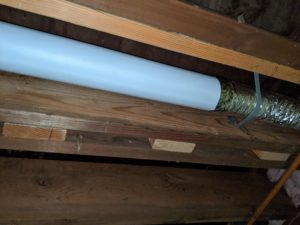PVC Dryer Vents
Over the past month I have responded to several problematic dryer vents in homes where the venting material used was PVC piping. In the following post I hope to explain why this material is sometimes used, why it isn’t recommended, and what to do about it.
PVC pipe is sometimes used for dryer vent construction when the installer does not specialize in HVAC services. Often times a handyman or plumber will install the vent, not knowing about the material. Sometimes, it’s even a do-it-yourselfer who tackles the dryer vent using PVC pipe. For those of you in this category I completely understand why you do it. PVC is easier to work with than sheet metal. It is easier to cut and hang. When it comes down to connecting joints, PVC pipe have easy to use elbows and they can be glued together. For these reasons I understand why this material is sometimes used.
Why should I NOT use PVC pipe? PVC is plastic and not conducive for dryer vents. When lint travels through a PVC pipe, static electricity created by the plastic will pull the lint to the sides. Over times this causes a 4” pipe opening to shrink dramatically. This leads to poor airflow which creates drying exhaust issues. When using the correct material, a dryer vent will still clog over time. The clogs will be at the various elbows and connection points. A PVC pipe will have buildup throughout and can clog anywhere. The other problem with a well put together PVC pipe is that there are rarely any weak seams. If a clog does occur the air has no place to escape. With conventional materials a seam, bend, or connection point can “pop” leading to lint blowing all over a building cavity. Although dirty, this break allows heat and moisture to escape and limits your immediate risk of a dryer fire. PVC piping will not do this which leads to water pooling and severe clogs. These clogs will cause your dryer to overheat and become a potential hazard.
To remedy PVC I suggest removing it and replacing it with the appropriate material. You can see my other posts about the appropriate venting material for your project. If you choose not to remove and replace I would suggest more frequent cleanings (at least once a year). This will prevent largescale buildup of lint along the walls of your vent. This will help to ensure that your dryer does not overheat.
As always, please call or email us today for information about having your vent switched from PVC.


